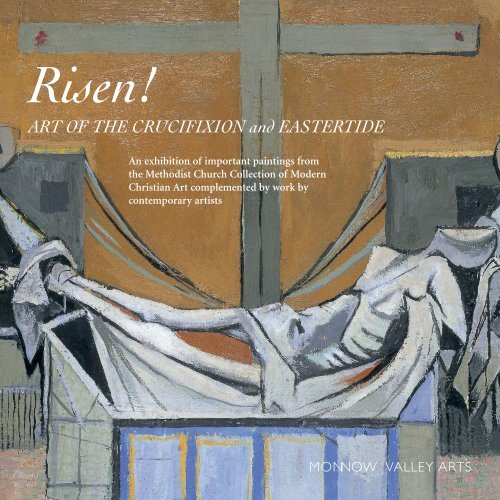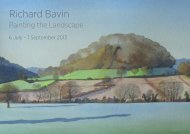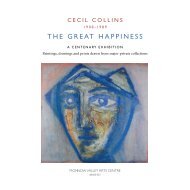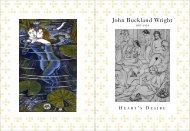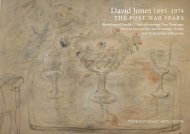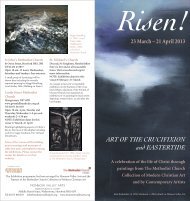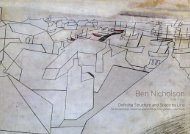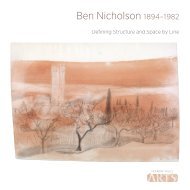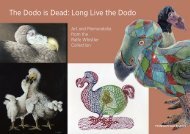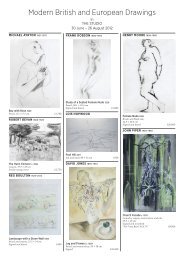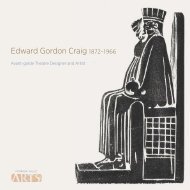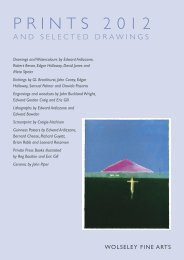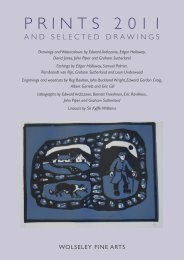Risen Catalogue - Monnow Valley Arts Centre
Risen Catalogue - Monnow Valley Arts Centre
Risen Catalogue - Monnow Valley Arts Centre
You also want an ePaper? Increase the reach of your titles
YUMPU automatically turns print PDFs into web optimized ePapers that Google loves.
<strong>Risen</strong>!ART OF THE CRUCIFIXION and EASTERTIDEAn exhibition of important paintings fromthe Methodist Church Collection of ModernChristian Art complemented by work bycontemporary artistsMONNOW VALLEY ARTS
Text extracts for works 1–9 are taken from ‘A Guide to the Methodist ArtCollection’ by Roger Wollen and others; published by the Trustees of theMethodist Church collection of Modern Christian Art 2010 and used bypermission.Other text entries by <strong>Monnow</strong> <strong>Valley</strong> <strong>Arts</strong> and individual artists.Acknowledgements<strong>Monnow</strong> <strong>Valley</strong> <strong>Arts</strong> acknowledges the help in preparing this catalogue given bythe Trustees of the Methodist Church Collection of Modern Christian Art andRevd. Geoff Cornell. Special thanks are given to Dr John Gibbs, Very Revd.Michael Tavinor, Very Revd. Nicholas Bury, Revd. Nicolas Lowton, all the artistsinvolved, the David Jones Estate, Robert and Matthew Travers, Hanneke van derWerf, Lord Griffiths of Burry Port and Sister Wendy Beckett.Photograph CreditsItems 1–9, The Methodist Church Collection of Modern Christian Art.Items 10, 11, 12, 13, 14, 15, 16, 20, 23, 24, 25, 26, <strong>Monnow</strong> <strong>Valley</strong> <strong>Arts</strong>.Items 17, 18, Piano Nobile. Item 19, Nicola Hopwood. Item 21, MichaelChaitow. Item 27, Mark Cazalet. Item 28, Richard Bavin. Item 29, HelenMcIldowie-Jenkins. Item 30, Paul Hobbs. All used by permission. The Publisherwould like to thank the copyright holders for permission to reproduce worksillustrated in this catalogue. Every effort has been made to contact the holdersof copyright material and the publisher apologises for any omissions.<strong>Catalogue</strong> published by <strong>Monnow</strong> <strong>Valley</strong> <strong>Arts</strong> to coincide with the exhibitions at:Piano Nobile, 129 Portland Road, London W11 4LWand<strong>Monnow</strong> <strong>Valley</strong> <strong>Arts</strong>, Middle Hunt House, Walterstone, Hereford HR2 0DY<strong>Catalogue</strong> © <strong>Monnow</strong> <strong>Valley</strong> <strong>Arts</strong>Foreword © Sister Wendy BeckettDesign by Helen Swansbourne, London SW6Printed by Disc to Print, London NW6ISBN 978-0-9559575-8-1IllustrationsFront cover: Graham Sutherland, The Deposition, 1947, detail. Cat. no. 8Right: Peter Rogers, The Ascension, 1963, detail. Cat no. 6Inside back cover: Greg Tricker, Magdalene, 2012. Cat. no. 18Back cover: Robert Wright, His ultimate destiny burst upon him with all clarity, 2012. Cat. no. 24
<strong>Risen</strong>!ART OF THE CRUCIFIXION and EASTERTIDEForeword by Sister Wendy BeckettExhibition datesPiano Nobile129 Portland Road, London W11 4LWThursday 7 February – Saturday 2 March 2013<strong>Monnow</strong> <strong>Valley</strong> <strong>Arts</strong>Middle Hunt House, Walterstone, Hereford HR2 0DYSaturday 23 March – Sunday 21 April 2013MONNOW VALLEYMiddle Hunt House, WalterstoneHerefordshire HR2 0DYTel: 01873 860529Email: info@monnowvalleyarts.orgwww.monnowvalleyarts.orgRegistered charity no. 1123483M M X I I IEaster PilgrimageDuring the period from late March to late April,other exhibitions of modern and contemporaryChristian art (some containing further worksfrom the Methodist Modern Art Collection) willbe held at various Border venues includingSt Peter’s, Peterchurch, Hereford Cathedral,Castle Street Methodist Church, Abergavennyand St John’s Methodist Church, Hereford.
ForewordThe Christian faith rests upon our certainty thatJesus, truly God and truly man, died and rose,ascended to the Father and sent us His Spirit. Withouta certainty of the truth of these mysteries there is noChristianity. The Gospels which are set in real timetreat these sacred events in sequence as theyhappened and this is how most artists have attemptedto portray them. With reverence and gratitude theyshow us the dead Jesus. Graham Sutherland imaginesHis broken body rather like the bread broken in theEucharist. Ceri Richards shows us the glory of therisen Jesus, astonishing His wondering disciples atEmmaus. This is the traditional and well-triedmethod of contemplating the greatness of God's giftto us. But there is another way of entering into thesemysteries and that is to see them as all intimatelyunited, from the death grows the resurrection andflowers in the ascension and the gift of the HolySpirit. I think we see this in a Craigie Aitchison. Hepaints the crucifixion but the cross is like a rocket oran arrow soaring out of the darkness into a heavenlyradiance: this is the dead and risen Jesus all in one. Inanother way the prayerful work of Mark Cazalet putsbefore us three views of a small humble wood. Eachview is the same and yet different, just as Good Friday,Holy Saturday and Easter Sunday all celebrate the oneoverwhelming gift from God. Cazalet's work, like thatof Greg Tricker, is profoundly contemplative, drawingus out of our own smallness into the unimaginablebeauty and truth of the Incarnation.Obviously every work in this exhibition has apowerful meaning for the Christian, but this artspeaks also to the non-Christian and the unbeliever,to everybody who knows that there is somethinggreater than ourselves.Sr Wendy BeckettMeditation on the Crucifixionand EastertideThe CrucifixionAnd when they had crucified him, they divided his clothes amongthemselves by casting lots; then they sat down there and keptwatch over him. Then two bandits were crucified with him, oneon his right and one on his left. Those who passed by derided him,shaking their heads. (Matthew 27: 35–36, 38–39)Meanwhile, standing near the cross of Jesus were his motherand his mother’s sister, Mary the wife of Cleopas, and MaryMagdalene. When Jesus saw his mother and the disciple whom heloved standing beside her, he said to his mother. ‘Woman, here isyour son.’ Then he said to the disciple, ‘Here is your mother.’ Andfrom that hour the disciple took her into his own home. (John 19:25–27)And it was now about noon, and darkness came over thewhole land until three in the afternoon, while the sun’s lightfailed. (Luke 23: 44–45)The Taking Down from the CrossAfter these things, Joseph of Arimathea, who was a disciple ofJesus, though a secret one because of his fear of the Jews, askedPilate to let him take away the body of Jesus. Pilate gave himpermission; so he came and removed his body. Nicodemus, whohad at first come to Jesus by night, also came, bringing a mixtureof myrrh and aloes, weighing about a hundred pounds. They tookthe body of Jesus, and wrapped it with the spices in linen cloths,according to the burial custom of the Jews. Now there was agarden in the place where he was crucified, and in the gardenthere was a new tomb in which no one had ever been laid. And so,because it was the Jewish day of Preparation, and the tombnearby, they laid Jesus there. (John 19: 38–42)2
The ResurrectionBut Mary stood weeping outside the tomb. As she wept she bentover to look in the tomb; and there she saw two angels in white,sitting where the body of Jesus had been lying, one at the head andthe other at the feet. They said to her, ‘Woman why are youweeping?’ She said to them, ‘They have taken my Lord, and I donot know where they have laid him.’ When she said this sheturned around and saw Jesus standing there, but she did not knowthat it was Jesus. Jesus said to her, ‘Woman, why are you weeping?For whom are you looking?’ Supposing him to be a gardener, shesaid to him, ‘Sir, if you have carried him away, tell me where youhave laid him, and I will take him away.’ Jesus said to her, ‘Mary!’She turned and said to him in Hebrew ‘Rabboni!’ (which meansTeacher). Jesus said to her, ‘Do not hold on to me for I have notyet ascended to the father. But go to my brothers and say to them,“I am ascending to my Father and your father, to my God andyour God.’’ Mary Magdalene went and announced to thedisciples, ‘I have seen the Lord’; and she told them he had saidthese things to her. (John 20: 11, 14–18)The Supper at EmmausNow on that same day two of them were going to a village calledEmmaus about seven miles from Jerusalem … While they weretalking and discussing, Jesus himself came near and went withthem, but their eyes were kept from recognising him… Then oneof them, whose name was Cleopas, answered him, ‘Are you theonly stranger in Jerusalem who does not know the things that havetaken place there in these days.’ He asked them, ‘What things?’They replied, ‘The things about Jesus of Nazareth, who was aprophet mighty in deed and word before God and all the people …’Then he said to them, ‘Oh how stupid you are, and how slowof heart to believe all that the prophets have declared! Was it notnecessary that the Messiah should suffer these things and thenenter into his glory?’ Then, beginning with Moses and all theprophets, he interpreted to them the things about himself in allthe scriptures. As they came near the village to which they weregoing, he walked on ahead as if he were going on. But they urgedhim strongly, saying, ‘Stay with us, because it is almost eveningand the day is now nearly over.’ So he went in to stay with them.When he was at the table with them he took the bread, blessed andbroke it, and gave it to them. Then their eyes were opened, andthey recognised him; and he vanished from their sight. They saidto each other, ‘Were not our hearts burning within us while hewas talking to us on the road, while he was opening the scripturesto us?’ (Luke 24: 13, 15–16, 18–19, 25–32)The AscensionSo when they had come together, they asked him, ‘Lord, is this thetime when you will restore the kingdom to Israel?’ He replied, ‘It isnot for you to know the times or periods that the Father has set byhis own authority. But you will receive power when the HolySpirit has come upon you; and you will be my witnesses inJerusalem, in all Judea and Samaria, and to the ends of the earth.’When he had said this, as they were watching, he was lifted up,and a cloud took him out of their sight. While he was going andthey were gazing up towards heaven, suddenly two men in whiterobes stood by them. They said ‘Men of Galilee, why do you standlooking up into heaven? This Jesus, who has been taken up fromyou into heaven, will come in the same way as you saw him gointo heaven.’ (Acts 1: 6–11)PentecostWhen the day of Pentecost had come, they [the apostles] were alltogether in one place. And suddenly from heaven there came asound like the rush of a violent wind, and it filled the entire housewhere they were sitting. Divided tongues, as of fire, appearedamong them, and a tongue rested on each of them. All of themwere all filled with the Holy Spirit and began to speak in otherlanguages, as the Spirit gave them ability. (Acts of the Apostles 2:1–4)3
Works from the Methodist Modern Art Collection1Elisabeth Frink(1930–1993)Pietà 1956Black ink, wash and watercolour, 85 × 68 cmSigned, inscribed and datedThe Pieta (Lamentation), normally portrayed as the sorrowingVirgin alone (or with other mourners) with the body of her deadson, is a subject for devotional meditation rather than a strictportrayal of the biblical narrative. In these terms, Elisabeth Frink’sdrawing is of the Deposition rather than a Pietà. The dead Jesus isshown, still crowned with thorns, after Joseph of Arimathaea hastaken his body down from the Cross but before wrapping him inthe linen cloth and placing him in the sepulchre or tomb. Jesus isshown as if propped up against a rock, with his right armextended upwards as it would be if Joseph were placing him gentlyin a sitting position on the ground.Elisabeth Frink commented: ‘I think I did a lot of drawingsthat were all entitled “Pieta” which, to me, has nothing to do withwhether the Virgin Mary was represented or not. Why should shealways be in a Pieta? These are details of the Christ from a “Pieta”– he is obviously dead and in a recumbent position. I wouldnot call it a “Deposition” because he is not being lifted downby anybody.’The drawings have much in common with the sculptures inthe sense that they have the same power and strength. ‘I amincapable of making little drawings. I always draw big ... I attackthe paper with large sweeping forms ...’ It is certainly true thatboth the Methodist Pieta and a similar work dating from twoyears later (currently in the collection of the Marquess ofAberdeen and Temair) have great strength and power, for thefigures are massive and overflow from the sheet of paper.4
2Patrick HeronCrucifix and Candles: Night 1950Oil, 51 × 41 cmSigned and dated top left cornerThe painting, set at night, shows a crucifix between a pair ofburning candles, standing on a table or altar in front of a leadedwindow. The painting has ‘a pronounced linear charcoal drawingon white primed canvas which the flat washes of oil colour edgedup to without hiding. They were all fixed with charcoal fixative,which acted almost like re-touching varnish on the areas ofoil colour.’Heron has said that when he painted Crucifix and Candles hewas fascinated by Titian’s The Vendramin Family in the NationalGallery in London. Titian’s painting of the brothers Gabriel andAndrea Vendramin and Andrea’s seven sons includes a crucifixand a pair of candles on an altar. The crucifix is a reliquary for afragment of the True Cross which had been rescued by a memberof the family when in danger of falling into a canal. The Heroncrucifix bears a schematic, linear figure of Jesus but the cross issubstantial enough also to be a reliquary.Crucifix and Candles: Night 1950 dates from shortly before hisfirst abstract experiments in 1953. Whether painting figurative orabstract works Heron has always been concerned with ‘pictorialexperience’ rather than ‘illustration’ or seeking a realisticportrayal of any subject. As he has said, ‘I am not a member of anychurch. The painting was made as a result of a purely pictorialexperience only.’ In that sense this is not an overtly religiouspainting.6
3Roy De Maistre(1894–1968)Noli me tangere 1952–8Oil on board, 95 × 67 cmSignedDe Maistre is an important figure in the twentieth-century arthistory of his native Australia, and also in Britain (he lived inEngland from 1938 until his death in 1968). Initially asinterested in music as in art (he studied both), some of his earlywork was concerned with the relationship between music andart and he developed an interest in colour which has beencompared to a musical approach and which continued toinform his work throughout his life. He developed a verypersonal style, combining elements from cubism and traditionalrealism and can be regarded as one of the century’s majorreligious artists, successfully tackling the difficult task ofpainting religious works which are contemporary in idiom butwhich can stand alongside the masterpieces of the past, that socolour and influence our expectations.A practising Roman Catholic, de Maistre commented, in aninterview in The Times in 1959, that ‘religion is not merely asubject for a painting but a perpetual reality which haspreoccupied me ever since I remember and is inseparable for mefrom every other thought’.The figure of Jesus, facing us, towers over the kneeling MaryMagdalene, who has her back towards us. It is still early in themorning and the sky is red with sunrise. The warm red-browncolour of both the landscape and Mary contrasts with the coolblues, white and greys of Jesus and the rocky garden. The mouthof the tomb, in a reddish stone or brick, is visible on the left, withmarks that can be read as ‘LO’. In addition to this painting, thereare two or three other versions of ‘Noli me tangere’, the largestand earliest dating from 1950–1, painted for the <strong>Arts</strong> Council’sFestival of Britain exhibition ‘60 Painters for 51’, with the others(as well as the Methodist work) being much smaller.8
4Ceri Richards(1903–1971)The Supper at Emmaus 1958Pen and ink, watercolour and gouache, 40 × 40 cmSigned inscribed and datedA drawing for the altarpiece for the Chapel of St. Edmund Hall OxfordThe altar piece at St Edmund Hall was a commission, the result ofinvitations to five artists (including two others represented in theMethodist Collection, Lee-Elliott and de Maistre) to submitproposals for a painting of this subject.Jesus sits facing the viewer, looking out of the picture, withone disciple sitting opposite him (with his back to the viewer) andone on the right. The table is represented schematically in contrastto the chair directly in front of us, which is a modern-looking,sturdy piece of furniture with four bars across the back. A jug, agoblet and two plates (one with three bread rolls on it) can be seenon the table. The whole scene is portrayed in blues, yellows andgreens.The drawing is largely an accurate version of the altar piece.The most noticeable differences are in the colour of the clothingof the disciple on the right (a bright ultramarine in the altar piececompared with a dirty bluish-green in the drawing); in the altarpiece, the disciple with his back to us has tilted his chair in hisreaction to the sudden recognition of Jesus and the backgroundhas some areas of changed colour. The other important variationis that the body of Jesus is sketched (in black outline) and is morenoticeable in the drawing than in the altar piece where his yellowrobe merges into the yellow background (which forms part of ayellow cross that is central to both paintings).In creating the collection Douglas Wollen had been moved byRichard’s two religious works, The Deposition in Swansea and theSupper at Emmaus at St Edmund Hall. He contacted Richardsabout the possibility of a further commission for the MethodistCollection. At the time Richards was just about to exhibit at the1962 Venice Biennale and was committed to his first Marlboroughshow (June 1963). He commented that he was ‘profoundlyinterested in the religious subject … I approach these subjectswith great care and circumspection for I cannot decide casually tojust “do” a religious subject.’ In another letter he mentioned thathe had ‘a small gouache study of the St Edmund Hall Supper atEmmaus painting and a very unfinished second version of aDeposition.’ The Emmaus study was chosen and added to theMethodist Collection.10
5William Roberts(1895–1980)The Crucifixion c. 1922Oil on canvas, 75 × 90 cmSignedThe scene is set on a hill top (with a wall running behind the placeof execution), with the roofs and domes of Jerusalem in thebackground. The composition of the painting is unusual in theway Roberts has placed the three crucified figures. It is usual toshow them in a line, with Jesus in the centre (as the Gospelsrecord), but Roberts has grouped them on the right of thepainting (as we look at it) in a tight triangle. Jesus appears as theleft-hand figure, although he remains central if you look at themfrom either left or right of the painting.At the foot of his cross the soldiers are casting lots for hisgarments; on the left, four Roman soldiers are holding back thecrowd (one man has climbed on his companion’s shoulders to geta better look); there is, in the group on the right, a man dressed inbrown/black who may be taken to be a representative of theJewish authorities. Around the foot of the cross there are threefigures – one in yellow, one bearded in brown and one in grey. Afourth figure, in blue and brown, with his back to the viewer, is inan ambiguous position. He is wearing boots similar to those wornby the Roman soldiers, and is kneeling towards the soldierscasting lots, but with his body twisted towards the cross and hisarms raised towards Jesus. Perhaps he is the Centurion (alreadybeing affected by the presence and bearing of Jesus) or perhaps heis just one of the soldiers casting lots (although his shirt is bluerather than red like the other soldiers) and is merely gesturing atJesus. The figure near the cross in grey looks like a woman (blondehair and red lips) and is probably Mary, the mother of Jesus.However, the way in which the grey robe has fallen forwardsuggests that it might be a man rather than a woman.The painting captures a moment shortly after the crucifixionshad begun. The two thieves are in pain (there is no apparentdistinction between the penitent and the impenitent thief) butJesus is tight-lipped with the growing agony; there is no wound inhis side, so the lance has not yet injured him and his cross carriesno inscription (perhaps it has yet to be put up).In the catalogue for the Roberts’ retrospective show at the TateGallery in 1965, Ronald Alley records that Roberts recalledpainting the Methodist Crucifixion ‘shortly after the end of hisservice as a war artist, at a time when he had some idea of enteringfor the Prix de Rome … A little later Rudolph Stalik, proprietor ofthe nearby Restaurant de la Tour Eiffel, came to his studio andtold him that he thought he had found a buyer for it. Roberts didnot discover until afterwards that this was Augustus John.’ Thepainting remained in the collection of the painter Augustus Johnfrom around 1923 until 1963 when it was sold by his estate, afterhis death, and acquired for the Methodist Collection.12
6Peter Rogers(born 1933)The Ascension 1963Oil on board, 125 × 100 cmSigned and datedIn the centre of the picture Jesus ascends in a whitish-gold cloud,his body already off the ground, arms raised upwards and his headthrust back, almost horizontally, in profile, in a style reminiscentof William Blake. On the left, the two men clad in white arestanding in the embrace of a deep-red flame that descends fromthe heavens and curves beneath them, while on the right a groupof disciples, undifferentiated except perhaps for Mary in a brownrobe, gaze upwards as Jesus is lost to view within the cloud andascends to heaven. This all takes place against a black and inkybackground with a faint glow on the horizon.Rogers’ whole life has been concerned with spiritual andreligious painting. His first religious work was a Crucifixion(1957) painted shortly after leaving Art School. It was three orfour years later that he produced his next overtly religiouspaintings. In 1960 he had a religious experience or vision at aconcert in the Royal Albert Hall in London. He saw a womanwalking towards him, a group of tightly knit people gazing up andbetween them a kneeling woman, also looking up. A great glowingball of light rolled into his field of vision and hovered above thecentral kneeling figure. There was also the sound of wavesbreaking on a seashore. Rogers interpreted his vision as theAscension.In a letter in 1992 Rogers says of his Ascension paintings thatthey embody his ‘conception of Christ as what I call “the channelof awareness.” This concept is based on such remarks by Jesus as“I of myself can do nothing, the Father within me does theworks.” In other words, the Christ is the channel for, rather thanthe initiator of, “the works”. For it is my belief that Jesus acted outthe life of Christ as it pertains to individual you and me. So whenhe said “No man comes to the Father except by me”, far frombolstering any sense of exclusivity all he was saying was that noone can find God other than through their own channel ofawareness.’ He comments that the Methodist Ascension is ‘themost graphic depiction – perhaps the most graphic I’ve everpainted – of my conception of Christ as “the channel ofawareness”.’14
7Francis Newton Souza(1924–2002)The Crucifixion 1962Oil on board, 107 × 77 cmSigned and datedJesus, clearly in great pain, hangs upon the cross with St John, in agrey cloak and trousers, on his right and a second figure, probablya woman, perhaps Mary the mother of Jesus, standing, in a brownrobe, on his left. Faint, ghostly echoes of the cross (and buildings)can just be made out in the background and the cross is topped bythe INRI sign. While the figures are, as it were, well lit, the scene isset in darkness. The sun (or moon) appears in the sky on Jesus’left-hand side. Perhaps it is the moon imposed over the sun, thesolar eclipse suggested in the Bible. It was traditional to portraythe sun and moon in crucifixions, these being pre-Christiansymbols taken over by the Church. They represent the New andOld Testaments, with the sun usually being found on Jesus’ righthandside.The painting is overtly expressionistic in style and the figureon Jesus’ left (on the right as we look) is conveyed in a cubist style,with four superimposed eyes, two looking at Jesus and twolooking out of the painting at the viewer.F.N. Souza was born in Goa, the Portuguese enclave in westIndia where he was brought up as a Catholic. He went to a Jesuithigh school in Bombay and in his teens thought of becoming apriest. God seemed a fearful person to him as a youth and ‘God’sservants went around in dread and awe of him’. In 1940 he wentto the Western-orientated Sir J J School of Art in Bombay but wasexpelled in 1945 for political activity, joining the CommunistParty in 1947. The same year he founded the Progressive ArtistsGroup and won the major award in the Bombay Art Societyexhibition. In the following year he was included in the exhibitionof Indian Art at the Royal Academy in London. He moved toLondon in 1949.As Edwin Mullins says, ‘Souza’s treatment of the figurativeimage is richly varied. Besides the violence, the eroticism and thesatire, there is a religious quality about his work which is medievalin its simplicity and in its unsophisticated sense of wonder. Someof the most moving of Souza’s paintings are those which convey aspirit of awe in the presence of divine power … in his religiouswork there is a quality of fearfulness and terrible grandeur whicheven Rouault and Graham Sutherland have not equalled in thiscentury’ (Edwin Mullins: F N Souza, Blond, London 1962).16
8Graham Sutherland(1903–1980)The Deposition 1947Oil on canvas, 50 × 45 cmSignedThe figure of Jesus is conveyed schematically, almost abstractly,lying on a tomb, in front of the cross which stands in the centre ofa gap in a lowish wall. Two strips of linen run in a gentle loop fromthe ends of the wall, either to, or behind, the cross. Jesus’ bodyforms a concave arc, lying unsupported on top of the lidless tomb,his legs resting on the tomb’s edge on one side and his shoulderson the other. His head, which is totally abstracted in a semi-circularor semi-spherical form, falls back horizontally. A linen cloth iswrapped around his feet and falls in a wide, low loop under hisbody and is secured at the right-hand end under his left shoulder.In 1962–3 Sutherland was approached to see if he wouldaccept a commission for a religious painting for the MethodistChurch. At the time, and for the next few years, he was unable todo so (he was busy with the East Acton Crucifixion, stained glassdesigns for a church in Ipswich, and portraits of The QueenMother, Kenneth Clark and Konrad Adenaur) and so in 1964 JohnGibbs took the opportunity to purchase The Deposition atSothebys and it was duly added to the Methodist Collection.The painting has an interesting history. It was bought byStephen Spender, who in turn gave it to his wife who sold it in1962, probably to provide the down-payment for their house atMas de St Jérôme in France. It comes from a transitional period inSutherland’s life – the progression from his early work to hismature style – and this placing, stylistically as well as chronologically,is borne out by Sutherland’s comment in a letter to DouglasWollen in 1964, ‘I think you are quite right in thinking that it doesnot fully represent my work in the field. Though there areelements in it which I like.’All his works from the late 1940s are influenced byphotographs he saw of the victims of the Nazi concentrationcamps and by Picasso’s recent work, as well as by Grunewald. Inaddition, it is perhaps not too fanciful to suggest that the clean,schematic lines of this painting, with the featureless face and thecool grey-blue colours, also represent a return to the influence ofSutherland’s early experience as a railway engineeringdraughtsman at Derby and his continuing interest in machines,revealed in many of his war-time paintings. The cool blues andgreys of the painting are central to the effect it produces on theviewer – an unemotional, calm and detached effect – andrepresent a good example of Sutherland’s claim (in an article inThe Listener in 1951) that ‘colour has two major functions. It isform and it is mood. That is to say that by its warmth or coldness,it can create form; it can also create a mood.’18
9John Brokenshire(born 1958)Pentecost c. 2004Oil, 76.2 × 76.5 cmThis abstract painting is perhaps best described by the artisthimself:The work was a long time in the making. Its final form cametogether as a synthesis of various key concerns I had beenliving with and pondering. First it came from a period ofinterest in shadow and light as pictorial elements and thedesire to create paintings from their interaction. Meanwhilethe white floating image was thanks to drawings I had beenmaking in the museum from stuffed birds. Over time I beganto visit snowy owls and wrens in my imagination and theybecame emblems of purity and grace.I was keen to get a very loosely represented image of a birdin space into my painting. But I wanted a sense of a birdhovering, not on a trajectory. At the same time I hoped to referin some way to angels: even if very obliquely by colour aloneor by suggestion. Darkness had to be the counterpoint to this.I had been looking at the depth of shade found in Rembrandtand Caravaggio. In such paintings enormous stillness anddrama can co-exist. I had been pondering how to convey asense of a powerful, compelling moment that can be so vividwithin figurative art. When the painting came together it feltas if these elements had meshed.For many years my painting had been an effort to createmy own vocabulary and to honour the natural world. A longstandinghope has been to convey a sense of the mysterywithin nature. But recently I have felt a shift and a longing torefer more openly to the inner world. I would define innerspace not as a space of sanctuary, but of involvement, journey,even encounter. There is more of a sense of urgency orpressure to deal with new material, related to transformationand the awareness of spiritual help and guidance. The titlePentecost was not suggested by me, but was the highest interpretationI could hope for from any viewer.I have long believed in God: I was first drawn to thespiritual in nature and in the practice of meditation and in myreading. I have been fortunate to take part in healing circlesand then have strongly felt a sense of a wonderful benignforce. I would search to re-encounter this presence, and wouldeven hope to find it in the process of painting. Gently andgradually I made my way back to the church. I was concernedabout the spiritual needs of my young children. Now I wish ithad been much sooner!20
Other Modern Works10Craigie Aitchison(1926–2009)Crucifixion and Mountain 2005Screenprint published by Advanced Graphics, 110.5 × 85.2 cmSigned and numbered 35/75 on the reverseAitchison was born in Scotland and had a career-long fascinationwith the Crucifixion after seeing Salvador Dali’s Christ of St Johnof the Cross in 1951. After studying law, Aitchison went to theSlade and studied under William Coldstream. In 1955 he touredItaly on a British Council Scholarship and the influence of earlyItalian painting is clearly to be seen in his work both in the way heused colour and in composition.Aitchison lived in London and in Italy and for some years hehad a ruined farmhouse in the Black Mountains where he wouldretreat for a month in the summer. His paintings and prints offavourite subjects – Bedlington terriers, flowers and crucifixionscenes – all follow a similar pattern, being in muted pastel colourswith blocks of colours and few extraneous details.In Crucifixion and Mountain, it is hard not to imagine BlackHill, under which the artist’s house stood, and the sheep thatroam the hillsides.22
11Eric Gill(1882–1940)Crucifixion 1917Wood engraving in gold ink on black paper P89 (first state), 12.4 × 8 cmAfter a window in York Minster. One of a few impressions made in gold on black paperEric Gill is one of the best known sculptors in Britain in the 20thcentury. After starting his training as an architect, Gill turned toletter cutting, then to sculpture and engraving. From 1907–24, helived in Ditchling, Sussex and surrounded himself with otherCatholic artist/craftsmen, forming the Guild of St Jospeh and StDominic in 1920. Making engravings for publication in StDominics Press publications and for sale through Londonbooksellers was a regular feature of his activities at this time.Many of his early religious sculptures and engravings have astrong medieval feel about them.In this engraving, Gill’s sublime line gives a dramatic power tothe figure of Christ emphasized by the printing in gold of thecorpus. Only a small number of these engravings in gold areknown. There was no edition of engravings at this time. Printswere produced on demand.24
12David Jones1895–1974Crucifixion c. 1928/9Carved and painted wood, 55 × 21 .5 cm plus base 12 × 23.5 × 2.5 cmReverse painted inscription JESV/ ESTO MIHI /JESUS (Jesus be my Saviour Jesus) and a crossA shallow small cross is incised into the base in the centreJones made this either at Capel-y-ffin or soon after at Pigottswhere Gill and his family had moved in 1928.In 1928 Jones visited France for the first time since the end ofthe Great War, where he had fought and been injured, as a Privatein the Royal Welch Fusiliers. The hills in the background of thepainting are similar to those depicted in paintings made in andaround Lourdes. To the right is a representation of the NewJerusalem, on the left a stag amongst trees and in the background,a bay surrounded by hills. Three birds surround the crucifiedChrist.Anne Price Owen wrote in David Jones, A Celebration of theAnathémata:There is an iconic, medieval ambience about many of his works thatovertly illustrate the Christian story. The bold definition of naturalforms create undulating rhythms, while the geometry of the crucifiedfigure echoes that of Jerusalem. The stone (hill), wood and water setthe scene, as does the stag which recalls the passage in theAnathémata ‘As the bleat of the spent day stag/ towards the rivercourse/ he, the fons-head/ pleading, ad fontes/ his desiderate cry.’26
Contemporary Artists13Hans Klein Hofmeijer(born 1957)Inkmen 2004/5(a) Inkman no. 557 2004Blue ink on printed sheet, 24 × 13 cmSigned and dated(b) Inkman No. 559 2004Blue ink on canvas 46 × 38 cmSigned and dated(c) Inkman No. 604 2004Blue ink on paper, 14 × 10 cmSigned and dated(d) Inkman No .608 2005Red ink on paper, 22 × 13.5 cmSigned, dated 19 February 2005 and inscribed “The image withoutword is the truth. Word creates confusion” (translated from theDutch)In the Inkmen series of works, all of which involve coloured inkson various supporting materials, the form is of a crucified person,who may not necessarily be the Crucified Christ, but is an imageof suffering. Klein Hofmeijer wrote “Inkman: levitation,elevation, detachment but also suffering and falling. Associationsthat coincide with a winged form that manifests itself in a spiritualisedblue…. Beauty that is uplifting and moving.” (Translatedfrom the Dutch)The motif has been repeated many times, each being subtlydifferent, and each with its own feeling. How the ink runs and isabsorbed on the surface affects the final visual result. KleinHofmeijer groups these works together on his studio walls, doesnot give them titles except Inkman and a number. The viewer andowner is left to decide how the react to the work.28
14John Cristoforou(born 1921)Crucifixion c. 1965Oil on paper laid down on canvas, 83 × 54.6 cmSignedJohn Cristoforou was born in England of Greek heritage. He spenthis childhood years 1930–38 in Greece where he studied at theAthens Academy of Fine <strong>Arts</strong>. After his return to the UK, heenlisted in the RAF. After the war, he took up his career as an artistand had his first show in 1949 in London. His work at this timewas powerfully gestural incorporating a bright and brilliant palletand was predominately abstract.In 1956 he settled in Paris and took French citizenship in1990. He became a major figure in the ‘New Figuration’movement from the 1960s onwards and showed the way out ofabstraction back to a free form of figuration.In the painting in this exhibition, the figure of Christ is shownin a striking red against a dark blue background and as the hourof darkness fell over the land. The sun is shown as being obscuredwhereas the body of Christ is radiating warmth. A halo of green isforming behind Christ’s head. Christ is not shown as suffering –more as a figure of hope.30
15Qassim Alseady(born 1949)Crucifixion with Nails 2004Oil on incised board, steel nails and bronze 18th century corpus, 40 × 40 cmSigned on the reverseQassim Alseady draws on his experiences in Iraq. It is about loveof a person, an idea, a place or country. The eternal struggle ofwar, hatred, ugliness and wickedness and their opposite, peace,love, goodness and beauty.Although brought up as a Muslim, Qassim Alseady hasprofound respect for the prophet Jesus. In this painting thesuffering crucified Christ is represented by the nails driven intothe board. Around the nails and corpus from a reused 18thcentury devotional crucifix are hieroglyphs or undecipherablewritings suggesting an unknown language from ancient times thatroots the Christian narrative in the land of Alseady’s birth.32
16Sam Wigan(British, born 1974)Crucifix 2000Bronze 2 of the edition of 6, 61 × 55 cmSam writes:The Crucifix is a potent icon. I have made a few since I startedsculpting. What I like about the abstraction of this crucifixionis that it gave me an opportunity to attempt to communicatethe ephemeral nature of this devotion; that is both embodiedby the story of the Crucifixion and is at the same time beyondeven that particular narrative.I also like the idea of doing the least to convey the essenceof that which one wants to communicate. Brancusi embodiesthis approach. The idea that, as soon as we put a form tosomething we have ourselves experienced, we do want tocommunicate [that form]; but in paring down to the leastform we can, perhaps, give more space to that sameexperience as it resonates within another.34
17Greg Tricker(British, born 1951)Magdalene – The Grieving 2009Oil, charcoal and acrylic on wood, 85 × 69.5 cm18Greg Tricker(British, born 1951)Magdalene 2012Etched and fired antique glass, 71.5 × 57cmIllustrated on inside back coverAlthough there is no scriptural justification, the tradition arose ofpainting what we call a Pieta. Artists showed Jesus, taken downfrom the Cross, and surrounded by His grieving followers. Therewere few of these at the end, since most had fled in fear, but ofcourse, His mother was there and St John the beloved disciple, andthe ever faithful Mary Magdalene. It became customary to showthe Virgin Mother in a state of silent grief, half-fainting, unableeven to stand. Mary Magdalene, on the other hand, is shown asabandoned to her sorrow. Mary the Mother of God is all dignity,Mary Magdalene is all wild protestations. She is angry, she mournsloudly and bitterly. Her sorrow is passionate. Tricker breaks awayfrom these stereotypes. His Magdalene experiences a sorrow toogreat for tears, too great for protestations. He shows her standingalone, at the hill of Golgotha. Behind her, in the darkeningobscurity, there loom the three crosses, all empty now. Even themoon has been emptied of its light: she is left in a world that hasfor her lost all warmth, all colour, all meaning. The image ispainted on those rough planks that Tricker uses to indicatedisintegration, yet Magdalene holds herself erect in her tragedy.Here is a beautiful being experiencing a very deep sadness. Trickersees her as grieving, not just for Jesus specifically, but in general forall mankind. United to Him as she is, Magdalene transcends thelimitation of time, and is aware of all the suffering that there hasbeen in the past and will be in the future. She is the archetypalfigure of grief. Here, as only as an artist can, Tricker brings beforeus the mystery of suffering. For many people, it is the oneinsuperable obstacle to belief in a loving God. If God truly loves us,why do we suffer so? Has He no pity for the dying child, thestarving people, the victims of human cruelty throughout thecenturies? He is God: why does He not spare us these sufferings? Inanother form, this is the question that the Pharisees hurled at Jesusas He hung, dying, ‘If you are the Son of God, come down fromthe Cross!’ But Jesus did not escape or avoid the sufferings that lifebrought in His way. He asked His Father ‘to remove this chalice,’the chalice of suffering, but He explicitly adds that He asks only ifit is the Father’s Will. Since it is not the Father’s Will that Jesus bespared, He accepts His painful death with love and trust, andthrough it redeems the world. God’s love is not shown by sparingus and manipulating circumstances for our happiness, but bystanding with us through whatever happens and making itredemptive. We long so much to be protected from the evil that lifebrings upon us, that it is very hard to accept everything lovingly.Mary Magdalene is pondering the immensity of our helplessness,sustained only by her understanding that Jesus tasted to the dregsthat same chalice of helplessness. He has not yet risen and she doesnot know the outcome, but her agonised prayer for all humanityunites us to her crucified Christ.Text from The Christ Journey. Sister Wendy Beckett reflects on the Art of GregTricker. St Pauls Publishing 2011 ©36
19Nicola Hopwood(born 1954)St Thomas’s Doubt, Ascension and the Coming of theHoly Spirit 2012Stained glass acid etched, painted and fired and assembled with leadA triptych, each panel 58 × 38 cmNicola writes:My work is about reflection – a continuous, two way processbetween the material (of glass) and the deep contemplation ofa theme. The process is enriched by the creative relationshipsdeveloped during the commissioning process.Thomas’s Doubt“Except I shall see in his hands the print of the nails, andput my finger into the print of his nails … I will notbelieve” John 20:25Christ’s Ascension“And when he had spoken these things, while they beheld,he was taken up: and a cloud received Him out of theirsight” Acts 1:9The Coming of the Holy Spirit“And suddenly a sound came from heaven like the rush ofa mighty wind … And they were all filled with the HolySpirit and began to speak in other tongues” Acts 2:238
20Nigel Groom(born 1947)Ascendit Deus 2012Acrylic with impasto and gold leaf on canvas, 90 × 90 cmSigned on the reverseNigel writes:The piece is a reworking of my painting of the Ascension fromthe Stations of the Resurrection which were completed in2011 and are partly inspired by the Gregorian setting of theMass of the Ascension.Alleluia! Ascendit Deus in jubilatione etDominus in voce tubae (Psalm 46:6)The Ascension for me is the great moment when the mysteryof the incarnation becomes visible in its fullness. It is anexpression of absolute joy, of being uplifted and taken out ofoneself in ecstasy (ekstasis).40
21Michael Chaitow(born 1944)Supper at Emmaus 1993Oil on canvas, 90 × 124 cm22Michael Chaitow(born 1944)Resurrection 2012Oil on panel, 84 × 90 cm(Not illustrated)Michael is a visionary painter whose work has a symbolistquality through themes developed from nature and naturalforms as well as the human figure. Tim Hilton writing in theGuardian said, “His paintings share something of the form andmetaphysical concerns of William Blake,” a view echoed bySister Wendy Beckett.In this painting there is transformation and transubstantiationtaking place. Along with fruits, water and wine are present,also the changing image of the skull signifying the transitionbeyond death: under the ‘gardening hand’ of Jesus Christ.The original inspiration came from Caravaggio’s Supper atEmmaus in the National Gallery, London.This painting is set within the natural material world. Death andresurrection are seen within the Individual and within Natureherself, participating in Christ’s redemptive sacrificial act.The human body and the landscape are one. The ascendingsun is the Divine Sun, giving life and renewal to all.42
23Marzia Colonna(born 1951)Small CrucifixBronze on Perspex stand, 20.6 cm highSigned and numbered 1/12A preliminary design for the Salisbury Cathedral Crucifix commission installed in 2002Marzia writes:Every decision, every chip off the sculpture or rip of the paperin the collages follows a language that I have developed totranslate how I feel…. What I am saying is: this is how it felt atthat moment. So I follow my instincts and trust them. My lifehas been and is full of fantasy, embracing often the impracticalto follow an ideal.This small bronze maquette was a 3D sketch for theSalisbury Cathedral paper Christ. The arms can be seen bothas carrying the weight of the dead Christ and as stretchedupwards in a symbol of the Ascension.44Paper and woodmaquette of theSalisbury Christ.153 × 60 × 12.5 cm
24Robert Wright(born 1949)“So that you also may believe” 2012Acrylic on canvas, 41 × 52 cmSigned with initials in left cornerCanon Robert Wright is the former sub Dean at WestminsterAbbey, former Rector of St Margaret’s Church and formerChaplain to the Speaker of the House of Commons. Since hisretirement in 2010, Robert has devoted himself to painting. Hehas acquired a reputation as a painter of abstract works withreligious and contemplative themes.Robert writes:An earthy orange rectangle draws us into the painting from itstextured white background and from this arises a golden pillarrising into a fiery red rectangle inviting the viewer to reflect onthe <strong>Risen</strong> Christ...25Robert Wright(born 1949)“His ultimate destiny burst upon him with all clarity” 2012Acrylic on canvas, 46 × 35cmSigned with initials in left cornerIllustrated on back coverRobert writes:The purple shadow of a cross leads the viewer across a neutralbackground of growing intensity into part of a golden circlewith rich, red underpainting...The title is a quotation from Elizabeth Johnson’s writings.Elizabeth Johnson is a feminist Christian theologian and Professorof Theology at Fordham University.The title is taken from John 20:31.46
26Andrea Mclean(born 1968)Jesus the Gardener 2012Oil on canvas, 90 cm diameterThe subject is taken from John 20: verses 14–17 where on Eastermorning, Mary Magdalene mistakes Jesus for a gardener. The<strong>Risen</strong> Jesus has a spade near him and a pair of secateurs. An angelsits on the round stone that has closed the sepulchre. A snailwhose little shell represents the cosmos, journeys at the feet of thefigures in the garden. This creature serves as a reminder that theNew Eden is not just for human beings but for everything.48
27Mark Cazalet(born 1964)Easter Tridium Triptych 2010Good Friday, Easter Saturday and Easter Sunday (Resurrection)Three drawings in coloured chalk on paper, each 50 × 80 cmThe inspiration for the drawings is the Suffolk Wood next to theartist’s house in Parham. This series of drawings reflects upon theEaster story; Good Friday, Easter Saturday and Easter SundayResurrection. Incorporated into the works are literary associations,especially the meditative writings of Thomas Merton andThomas Traherne’s poetry, combined with a sense of place andmemories and mood.The three landscapes convey an interior stillness, a silentwatchfulness, in which light is the medium of hope andregeneration. Charles Dickens called light the mind of creation.Here the light of the world comes and goes a Paschal and dailyresurrection.Good Friday50
Easter SaturdayEaster Sunday51
28Richard Bavin(born 1957)The Empty Tomb 2012Watercolour on paper, 54.5 × 81.5 cmSigned and dated on the reverseThe painting is set within the empty tomb looking outwardthrough the entrance. It is an image primarily of absence but theemptiness is of a new beginning, of despair turned to hope. A pileof linen lies abandoned, marks on the floor moving towards theentrance where the stone is partially rolled away.52
29Helen McIldowie-Jenkins(born 1964)Love Hanging on a Tree 2012Egg tempera on panel with 23 ct gold leaf, 90 × 50 cmInscribed “Love is Patient, Love is Kind”Helen writes icons in the traditional way using egg tempera on alined lined, gessoed wooden panel. Gold leaf is applied by watergildingover a bole ground and then burnished. The makingprocess has been deliberately left exposed at the edges to show thatthis is a modern icon.This large icon of the Crucifixion has late medieval Italian and19th century Russian influences. It reinterprets a panel c. 1260s, byBonaventura Berlinghieri (Uffizi, Florence). The mysterious‘Y’-shaped Cross, possibly a symbol of the Tree of Life or aconflation with a ‘Furca’ (an antique type of gibbet), was thesubject of the iconographer’s MA research at the CourtauldInstitute. The blue cross, glazed in lapis lazuli, references theartist’s particular interest in 13th-century Franciscan bluecrucifixes from central Italy and Franciscan spirituality. The nailsare shown piercing the wrists – not the hands – of the corpus, inaccordance with modern understanding of crucifixion methods.The stylised shell gold highlights on the loincloth symbolise theglorified Christ and references the techniques of 18th–19thcentury Russian master iconographers from Palekh and Mstera.The concept, title and extract from 1 Corinthians 13, are takenfrom a published song, composed 30 years ago by Victor Dejean.54
30Paul Hobbs(born 1964)The Body of Christ 2004–7Four paintings: Head of Christ, Side of Christ, Hand of Christ and Feet of ChristAll acrylic on paper, each 47.5 × 33 cmConceived for the 2005 Cathedral touring exhibitionKindly loaned by Dean Close School, CheltenhamThe loosely drawn forms and the criss-crossed lines suggest thecuts of the whips, the blood and the bruises of the beating JesusChrist received before the Crucifixion. They depict the nails in hishands and feet, and the spear in his side. We see Christ’s face inseveral different positions at once, his mouth opening as he speakswords of forgiveness, or cries out from the cross in triumph, “It isfinished”. The whole series for which these works were made canbe seen on Paul’s website.56
Biographies and contact details of contemporary artistsQassim AlseadyQassim Alseady was born in Baghdad in 1949 andstudied at the Academy of Fine <strong>Arts</strong> in Baghdadfrom 1969–73. He was a professor of arteducation in Iraq and exhibited his own work inIraq, Lebanon, Syria, Yemen and Libya. AfterSaddam Hussein came to power in 1979, lifebecame increasingly difficult for artists and he wasarrested, detained and tortured before beingreleased. After leaving the country, he settled inthe Netherlands.Alseady currently has an exhibition “GoodMorning Baghdad” at the Gouda Museum (until28 February 2013). During 2013 there will be amajor retrospective at the National Museum ofIraq in Baghdad.He is represented by Frank Welkenhuysen inUtrecht, the Netherlandsinfo@kunstexpert.comwww.kunstexpert.comRichard BavinRichard studied fine art at Hereford College of<strong>Arts</strong> and the University of Gloucestershire(Cheltenham School of Art), graduating with firstclass honours. For the past five years he has beenbased at <strong>Arts</strong>ite 3, the community studios incentral Hereford. Richard is predominately alandscape painter with a passion for trees.Throughout the year he spends time outdoors,sitting quietly, making observational studies as astarting point for more expressive studio-basedwork in watercolours and oils. Applying paint inlayers, he introduces ambiguities of light andspace which slowly open up to the viewer. His aimis to create images which evoke the character of aplace through its seasons and moods.5 Millway, Wellington, Hereford HR4 8AS01432 830168 / 07792 298271bavin@madasafish.comwww.richardbavin.com58Mark CazaletMark studied at the Chelsea School of Art and theFalmouth School of Art, followed by studentshipsand scholarships to France and India.He is recognised as one of Britain’s foremostpainters of spiritual themes. His work has beenexhibited in most of the cathedrals of Britain andhe has been represented in most major exhibitionsexploring Christian themes.After many years living and working inLondon, Mark now lives in Suffolk and London.In 2012 he was artist in residence at the Josephand Anni Albers Foundation, Connecticut. He iscurrently exhibiting with Roger Wagner at TheMaltings, Snape. Recent commissions include twoetched and engraved glass screens for the Churchof the Community of the Resurrection, Mirfield,and work for the Church of the Epiphany, Doha.info@markcazalet.co.ukwww.markcazalet.co.ukMichael ChaitowMichael studied at Central St. Martins with CecilCollins, after a few years as a commercial artist inadvertising. A further formative experience was atwo year Commonwealth painting scholarship inIndia. His main influences are Eastern churchicons, Hindu stone carving and artists such asCollins, Sutherland and Bacon.He is a painter, seen in the romantic symbolisttradition of Blake, Palmer and Collins.15 Selbourne Close, Weston, Bath BA1 3HUmichaelchaitow@hotmail.co.ukwww.michaelchaitow.comMarzia Colonna ARBSMarzia was born in Pisa, and attended art schoolin Pisa, the Academia di Belle Arti and at MorleyCollege. For many years until it closed, she wasrepresented by the Hart Gallery in London.Commissioned works can be found in ParchmentStreet, Winchester; Weymouth and PortlandNational Sailing Academy; Sherborne Abbey; andSalisbury Cathedral. She lives and works in Dorset.Marziacolonna@aol.comwww.marziacolonna.comNigel GroomNigel has a background in letterpress printing anddesign, worked in Africa as a lay missionary andbecame an Augustinian Friar. On leaving thereligious life, he became a teacher of theology andmusic and later trained in analytical psychology.He has recently retired as a Jungianpsychotherapist after 30 years. He is a composerand violinist, leads study groups on prayer andspirituality and works as an artist from his studioin Malvern.In recent years he has exhibited his work inand around Malvern, Wells Cathedral, WorcesterCathedral, Buckfast Abbey, Marlborough andNewton St. Margarets, Herefordshire. In 2013,three triptychs and his series of the Cross andResurrection will be exhibited at Wells Cathedral,and his Stations of the Cross at St Mary’s,Prestwich.35 Wyche Road, Malvern, WorcestershireWR14 4EFnigelgroom@hotmail.co.ukwww.nigelgroom.comPaul HobbsPaul was born in Nigeria, studied Social andPolitical Science at Pembroke College, Cambridge,and Fine Art at Byam Shaw School of Art. He nowlives and works in Gloucester and makes paintingand sculpture exploring contemporary issuesfrom a biblical perspective, using variouslyabstract, symbolic and conceptual styles. Theseexhibits are toured to schools, churches,cathedrals and festivals where Paul leads talks anddiscussions about the artwork, the Christian faithand his methods of working. He has commissionsat Danbury Mission, Danbury, Essex; Dean CloseSchool, Cheltenham; and Lambeth Palace.23 Alvin St, Gloucester GL1 3EHpaul@arthobbs.comwww.arthobbs.comNicola HopwoodNicola is a stained glass artist living on the borderbetween England and Wales. She uses handmadeglass to create windows for churches, hospitals,
libraries, schools and private homes. She enjoysworking within the context of the church,exploring great themes in new ways.Examples of her work can be seen at Lyonshall,Orcop, Cusop, Frome’s Hill, Little Dewchurch inHerefordshire; Clunbury in Shropshire; Astley,Hampton and Cropthorne in Worcestershire;Newent in Gloucesteshire; and at Priston inSomerset.Honeysuckle Cottage, Bronydd, Clyro, HerefordHR3 5BXnickyhopwood@waitrose.comwww.nicolahopwood.co.ukHans Klein HofmeijerKlein Hofmeijer is a Dutch painter who marriesimagery and words together to create a visualrecord of his thoughts and feelings.Jhm.kleinhofmeijer@upcmail.nlwww.kleinhofmeijer.nlAndrea McLeanAndrea was born in Wales and grew up in theForest of Dean. She studied at Falmouth School ofArt and the Slade. She was an Abbey MajorScholar at the British School at Rome and artist inresidence at Gloucester Cathedral. Andrea’spainting ‘A Contemporary Mappa Mundi’ is inthe British Library collection where it is ondisplay near the entrance to the Map Room. She iscurrently working on a book on the Visionarycartography in the work of William Blake and hasgiven talks on Blake to the Ledbury PoetryFestival, where she now lives.info@andrea-mclean.co.ukwww.andrea-mclean.co.ukHelen McIldowie-JenkinsHelen has made icons professionally for overtwenty years, regularly undertaking commissionsfor Roman Catholic and Anglican cathedrals,churches and schools, as well as icons forordinations, memorials and private devotion.Helen has a studio in north-west London andholds an MA in Late Medieval Art History(Courtauld Institute). She also works as an Icon<strong>Catalogue</strong>r at MacDougall’s Russian Art Auctions(London) and leads Icon Painting Retreats in Italyand Sinai.Many examples of her work can be found inthe UK and abroad.Tel 020 8452 9078helen@elenisicons.co.ukwww. elenisicons.co.ukGreg TrickerGreg Tricker was born in London and from anearly age was deeply inspired by the life andpaintings of Vincent van Gogh. Tricker’s profoundand simple style of work is rooted in the mysticaltradition of Modern British art, for which theartist has gained international recognition.Qualities of myth and innocence of spirit, akinto the folk art tradition, feature in his work. Hehas produced a number of themed books andexhibitions, notably: Paintings for Anne Frank(exhibited at Peterborough Cathedral and StClement Danes, London); The Catacombs and StFrancis of Assisi (Piano Nobile Gallery, London);and the Life of Kaspar Hauser and Bernadette ofLourdes (2006 & 2008, Piano Nobile Gallery).The Christ Journey, a major retrospective tocelebrate the artist’s 60th year, was shown atGloucester and Westminster cathedrals in 2011,when a book on his work, written by Sr WendyBeckett, was published by St Paul’s Publishing.His most recent cycle of work, Pillars of Faith,depicting some of the most influential men andwomen in Christendom was shown at SalisburyCathedral and Sarum College in 2012. In Aprilthis year his latest cycle based on the Life of Joanof Arc will tour to Rheims Cathedral.Greg Tricker is represented by Piano NobileTel 020 7229 1099 art@piano-nobile.comSam WiganBorn in Devon, South West England, in 1974, Samwas educated at boarding school (Ludgrove Prep,then Eton College) and then ManchesterUniversity, where he studied History of ModernArt. Life education started soon after, with anardent pursuit of a teaching of the Heart. This ledto a meeting with the Avatar of India, Sai Baba,and then life coach and spiritual teacher Dr. John-Roger both of whom have demonstrated to Samthe universality of Spirit.Sam set out to sculpt as a profession in 1998,around the same time that he met the great DavidWynne who said “go for it”. David has been aninspiration, teacher, and profoundly heartfeltfriend for Sam.Since 1998 Sam has created a continuousstream of work, most of which has been theproduct of commissions, including for collectorssuch as Charles Saatchi and Crispin Odey, and forinstititions such as the Goldsmith’s Hall amongothers. The commissioning process is Sam’sspecilization, bringing into being sharedinspiration and communion of ideas.Although initiated into the sculpture ofabstraction in his teens, and then going on tostudy the history of conceptual art at university,Sam was drawn to figurative work and toexpressing himself through a celebration of thenatural world. It is an ongoing discovery of hisown voice, and in particular the opportunity toconvey both narrative and feeling through thework.Sam’s portfolio numbers several Christ figuresand crucifixions. Indeed, the first work he hadcast to bronze was a small crucifx. The Christ is aconstant theme within his work and an everpresent guide to what works (which, in case youhadn’t figured it out yet, is Loving!).Sam is married with two children and currentlylives in the beautiful English countryside.Lynchet Barn, Fyfield, Pewsey, Wilts SN9 5JSsam@samwigan.comwww.samwigan.comRobert WrightRobert began painting in 1998. He is self-taughtand cites Wassily Kandinsky, Ben Nicholson, MarkRothko, Sean Scully and Terry Frost as majorinfluences on his work. He is especially concernedwith the balance of his paintings and hopes thatthis reflects his simultaneous exploration ofcontemplative prayer. Working mostly in acrylics,in his paintings Robert’s art comes from the heartand the soul, opening deeply evocative spaces andperspectives to challenge the viewer.priestpainter@googlemail.comwww.robertwrightartist.co.uk59
Mission Statement<strong>Monnow</strong> <strong>Valley</strong> <strong>Arts</strong><strong>Monnow</strong> <strong>Valley</strong> <strong>Arts</strong> is a registered arts charity based on theborder with Wales in a deeply rural setting. It is managed byRupert Otten and Hanneke van der Werf and reports to a Boardof Trustees.Since it was founded in 2007 by Rupert Otten and Hanneke vander Werf, we have brought to an area with little exposure to fineart the experience of exhibitions of national and internationalimportance. The exhibition programme concentrates on art witha spiritual dimension that complements the outstanding beauty ofthe setting and the modern gardens that have been created aroundthe centre.As well as indoor exhibitions, the centre runs an artist’s studiowhere smaller more focused exhibitions are held and where artistscan stay and work. Within the 4-acre grounds, the centre displayssculpture and hosts an annual sculpture exhibition. <strong>Monnow</strong><strong>Valley</strong> <strong>Arts</strong> is also one of the venues where visitors can see part ofArt & Memory, the National Contemporary Collection ofMemorial Art on permanent loan from the Lettering andCommemorative <strong>Arts</strong> Trust. The centre has a particular interest incarved lettering as an art form.Recent exhibitions have includedImage and Word: The Julian Francis Collection of Prints andPrivate Press Book. 2012 (touring)Ben Nicholson: Defining Structure and Space by Line. 2012Images of Power from the Jeffrey Archer Political CartoonCollection. 2011 (touring)The Romantic Landscape I and II. Palmer, Piper, Sutherland andMaynard Smith. 2001 & 2008David Jones: the Late Paintings from private collections. 2010Edward Gordon Craig: Stage Designs, Drawings, Engravings andPhotographs. 2010Carved Lettering by Tom Perkins and Calligraphy by GaynorGoffe. 2010Edward Ardizzone: The Uncensored Eye. 2009Eric Gill. The Sir Christopher Bland Collection. 2009British Studio Pottery. The collection of a distinguished academic.2009Cecil Collins. The Great Happiness. Centenary Celebration. 2008John Shaw: A Showcase. Carved lettering. 2008David Jones: The Stadlen Collection of Poetic Works. 200760
The Methodist Church Collection ofModern Christian ArtThe Collection is a valued and valuable resource for exploring theChristian faith in a form that is accessible to people of differentfaiths or none. It consists of modern, challenging depictions ofevents in the life of Jesus by significant artists. It is thus asignificant opportunity for Christian mission: for engaging withthe work of God in the world in the light of the story of Jesus.Art both offers insight to and asks questions of the viewer in waysthat are open and inviting.If you are interested in exploring the possibility of exhibiting theCollection, please contact the Administrator. He will guide youthrough, visit you to see the proposed arrangements, and thenmake a recommendation to the Trustees, who will give finalapproval.The Collection is administered by a Board of Trustees.If you are interested in seeing or loaning all or part of theexhibitions please contact:ExhibitionsMethodist Modern Art CollectionEnfield Circuit OfficeSouthgate Methodist ChurchThe BourneLondon N14 6RS020 8886 8067methodistart@yahoo.comThe Collection is housed in Oxford. Most items can be viewed online at www.methodist.org.uk/static/artcollection/index.htmGreg Tricker, Magdalene, 2012. Cat. no. 18


